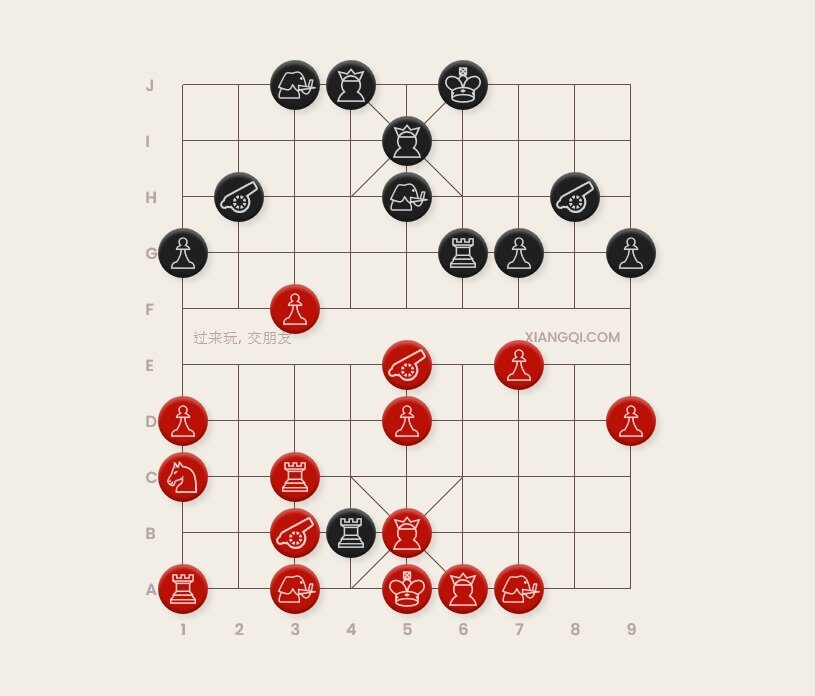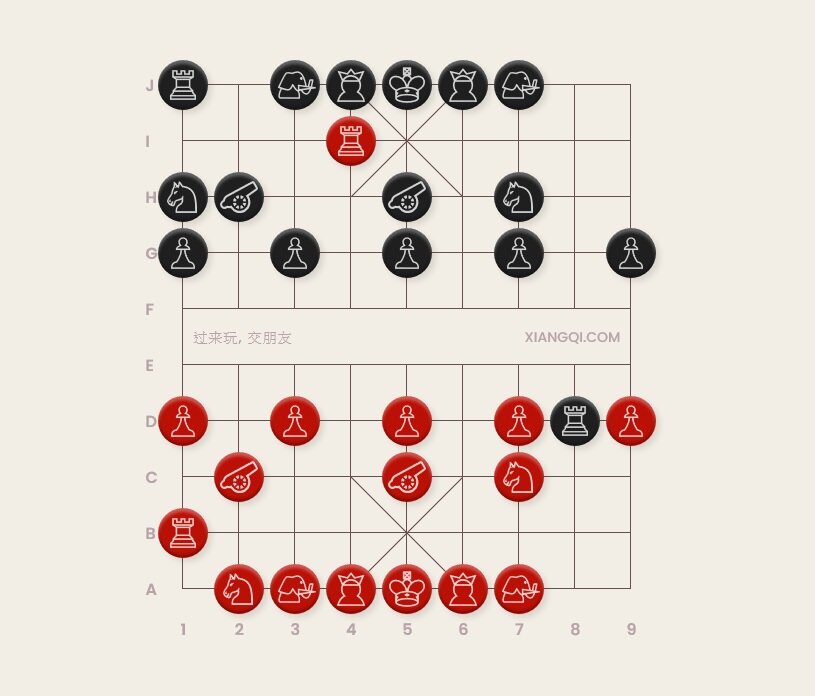Basic Xiangqi (Chinese Chess) Midgame Tactics 05 Sacrificing Material
Author: Jim Png from XqInEnglish
This article is the fifth article in a series of articles introducing the basic tactics used in Xiangqi (Chinese Chess). In this article, the author will focus on introducing the tactic of sacrificing material. This tactic is very commonly used in Xiangqi play and can be employed to achieve many different goals.
The article will be divided into the following sections:
Sacrificing to gain the initiative
Sacrificing Material for a Draw
Some Background Theory
Sacrificing material is defined as the act of deliberately allowing the enemy to capture one or more friendly pieces such that gains in other areas can be obtained. Often, a small sacrifice, if successful, will lead to gains in the overall situation. A sacrifice can also occur in the form of using a valuable piece to trade for a less valuable piece with a clear goal in mind. (1 页 146) (2 页 75) (3 页 135-136)
These gains include:
l the opportunity to go for a kill,
l to gain the initiative,
l to aim for a draw,
l to checkmate, et cetera.
Often, there is an element of surprise, and the pace on the board becomes accelerated very quickly. Tactics to sacrifice material to try to gain the initiative is also present in many opening traps. They can be considered to be the same as gambits in International Chess.
Grandmaster Liu Dianzhong also mentioned that many beginners often sacrifice material for various purposes. Although their attempts may or may not work, their aggressive and proactive spirit deserves commendation. (2 页 75)
The tactic of a sacrifice differs from a pseudo-sacrifice whereby lost material is gained back later on. With a sacrifice, the material lost is permanent.
Sacrificing to checkmate
The ancient manuals, matches by the Masters and Grandmasters, and Xiangqi endgame compositions are full of such examples. The author has selected a few examples which he deems to be textbook material on the subject.
Diagram 1 Sacrificing material to checkmate
The position shown here has been used in many contemporary books and magazines. It was the actual position reached when Beijing's Master Fu Guangming 傅光明 took on Hu Yipeng 胡一鹏 from Qinghai. The event was the 1966 Chinese National Individual Xiangqi Championships.
Red had been careless and played R2=7 to capture a black horse before this position. Black's turn to move.
Enjoy!
17. ………… R4=5!
Chariot sacrifice! This is a bold move to tear open the enemy defense.
18. A4+5 …………
If Red advanced the King to capture the Black Chariot, Black would checkmate with the following moves: 18. K5+1 C2+6 19. K5+1 …………(If Red played K5-1, Black checkmates with R6+6.) 19. ………… R6+4. Checkmate.
18. ………… C8+7
19. A5-4 …………
If Red chose to move the Elephant away, Black checkmates with R6+6.
19. ………… R6+6
20. K5+1 C2+6
The Red Cannon cannot move because it is sandwiched!
21. K5+1 R6-2
Checkmate.
This brilliant checkmate would not have been possible if Black had not sacrificed his Chariot for the first move.
The author considers it textbook material on ranked checkmates and possible tactical combinations with the Chariots and Cannons.
Sacrificing to gain the initiative
Sacrifices are commonly used to break the deadlock in an otherwise even situation. The following example is the Horse Gambit for Thirteen Move Kill from the ancient manual, the Secret in the Tangerine.
The Secret in the Tangerine. Volume 1 Board 1
Same Direction Cannons: Ranked Chariot vs. Filed Chariot. Red would try to attempt a Horse gambit.
顺炮横车破直车弃马局 (shùn pào héng jū pò zhí jū qì mǎ jú)
The Secret in the Tangerine has been one of the most influential pieces of Xiangqi literature for centuries. It was the main go-to book by WH Wilkinson, who wrote the earliest book on Xiangqi in English in 1893. It was called A Manual of Chinese Chess.
Wilkinson's book was mentioned in HJR Murray's A History of Chess when Murray introduced Xiangqi.
In volume 1 of the ancient manual, the Same Direction Cannons: Ranked Chariot vs. Filed Chariot was discussed. In this first board, we will see one of the oldest opening traps.
1. C2=5 C8=5
Same Direction Cannons.
2. H2+3 H8+7
3. R1+1 …………
Ranked Chariot.
3. ………… R9=8
Filed Chariot.
The opening system is defined. It would be the Same Direction Cannons: Ranked Chariot vs. Filed Chariot.
4. R1=6 R8+6
In ancient times, this was usually the move that Black would play.
Instead of R8+6, Black would usually choose to continue with R8+4/A6+5/H2+3/H2+1 in modern times. It would lead to a game with a slower pace of play, which would be compensated with Black having more adequate defense.
5. R6+7 H2+1
6. R9+1 …………
Horse Gambit!
Diagram 2 Infamous Horse Gambit from the first Board in the Secret in the Tangerine
The left Red Horse is offered as a sacrifice in perhaps the earliest opening trap in Xiangqi history. The first few boards in volume one of the ancient manual would discuss this gambit.
The idea behind the gambit is simple. Red would want to attack Black's central Pawn, but the Black Horse was guarding it. Hence, by sacrificing his unmoved Horse, Red would threaten to attack Black's proper Horse with C8+5.
6. ………… C2+7
In the first board, Black accepted Red's sacrifice.
Capturing the Red Horse would leave Black's Cannon rank vulnerable, becoming Red's immediate target of attack.
Modern-day opening studies have suggested that Black would have been much better off if A6+5 or R8=7 was played instead of capturing the Horse. Black's Cannon Rank would still be protected.
7. C8+5 …………
Once the Black Cannon was out of the way, Red would immediately start attacking Black's Horse, the only piece protecting Black's central Pawn. By attacking the Black Horse with C8+5, Red would be preparing his way for an attack on Black's center.
The position shown would be the main topic of discussion for the first board in the Secret in the Tangerine.
There are five major variations and dozens of sub-variations that were given in the book.
Due to the scope of this article, the author has chosen to show the first two variations and the last variations.
Variation 1: 7. ………… H7-8
7. ………… H7-8
Of the five major variations discussed, this would be the worst counter for Black. After H7-8, Black's central Pawn would be unprotected, and Red would be able to start attacking the center.
Indeed, after retreating the Horse, Red's advantage leaped to about 300 points to 6000+ points (level 30) in analyses by the computer after H7-8 was played.
A6+5 for a counter-sacrifice would be the best reply in this situation.
8. C5+4 A6+5
Red attacked as planned. There would be no escape for Black.
If A4+5 were played, Red would immediately play R9=6 for the Iron Bolt Checkmate.
If the Black Cannon moved away, Red would have a powerful Cannon controlling the entire central file.
9. R9=6 …………
Red threatens with an Iron Bolt Checkmate.
9. ………… K5=6
10. +R+1 A5-4
Bold sacrifices were often seen in the ancient manuals, which represented the romantic style of play in the early stage of Xiangqi.
The first board in the Secret in the Tangerine was no different as Red boldly sacrificed his Chariot for the kill.
Another variation (Variation 2 in the ancient manual) is that Black would not capture the offending Red Chariot and play K6+1 instead. It is not given in this article.
11. R6=4 C5=6
12. R4+6 K6=5
13. C8=5
Checkmate.
This line is the infamous Horse Gambit for Thirteen Move kill, probably one of the earliest recorded opening traps in Xiangqi history.
Variation 5: 7. ………… C2-2
7. ………… C2-2
In this variation, Black would try to find compensation with C2-2. Unfortunately, Black demonstrated that he did not understand the gravity of this situation. Red would be simply faster in the kill.
8. C8=3 C2=7
9. C5+4 A6+5
10. R9=6 K5=6
11. +R+1 A5-4
There was another discussion of K6+1 in response to Red's aggression, but a modern-day study has concluded that it would not be viable either.
12. R6=4 C5=6
13. R4+6 K6=5
14. R4+1
Red would end the game with C3=5 on the next move.
Variation 19: 7. ………… A6+5
7. ………… A6+5
This variation is the best option for Black. Black would fortify his central file and offer counter-sacrifice, which would halt Red's attack.
8. R9=4 …………
A contemporary study has suggested that C8=3 should have been played. Red would have gained back lost material and would still be on the offensive end.
R9=4 would give Black a chance back into the game.
8. ………… R8-4
R1=2 was also discussed as variation 20 in the ancient manual where Black tried to fight back aggressively. It is not given here.
9. R4+7 R1=2
10. C8=3 R8=7
11. C5+4 R2+4
12. A4+5 R2=5
13. R4-2 E7+9
14. K5=4 R7-2
15. R6-4
In the ancient manual, there was a comment: "Red would be able to gain back lost material, but a win would not be guaranteed."
However, a modern-day study has suggested that Black could have played C2-6 for a pseudo-sacrifice.
Red could only answer with C5=8, and Black would immediately play C5=2 to capture material, simplifying the game to Black's favor.
That is why A6+5 would have been the best counter for Black.
There are still many other sub-variations that have not been listed.
But the main idea in this example is that Red can crack open Black's defense for a kill by sacrificing his Horse on the 7th move. Red would continue to play aggressively after sacrificing material to gain a winning position and even reach checkmates in many different situations.
Although A6+5 is regarded as the best counter for Black, as Black refuses the sacrifice, Red will still have the advantage if played correctly.
The author has translated the entire ancient manual into English which is for sale on Amazon.com.
Sacrificing Material for a Draw
Sacrificing material to aim for a draw is less seen in Xiangqi. Nevertheless, it is still a brilliant technique that can save a game. The next board that the author presents is one such situation.
The 2015 Chinese National Xiangqi Individual Championships was one of the most heated tournaments in the event's history. The tournament had just adopted a brutal elimination format. Two games were played for each round whereby the two contestants would have to try to win on aggregate to make it to the next round. In the event of a draw (e.g., 1W1L, 2D), a tie-breaker would be played in the form of a rapid Xiangqi match with special stipulations. There were many upsets that year.
We shall look at the round of 32 when tournament favorite Grandmaster Wang Tianyi battled Zhong Shaohong. Wang had been in contention for winning the tournaments this decade, and he was able to win the tournament several times in the past decade.
Unfortunately, his encounter with up-and-coming Zhong Shaohong proved that he was not to shine that year. In the first match, Wang Tianyi took Red and played the Central Cannon Opening, and Zhong countered with the irregular Right Three Step Tiger.
Determined to win his match, the Grandmaster attacked relentlessly, but the young Zhong Shaohong (born in 1991) never backed down and fought fearlessly. Before the match, Zhong Shaohong's most significant achievement was representing China in the Asian Xiangqi Federation Youth Tournament, which he won.
(4)
Diagram 3 2015 Wang Tiangyi Draw Zhong Shaohong
The position shown here was the position reached at the 56th ply.
It was Red's (Wang Tianyi) Chariot-Horse combination vs. Black's (Zhong Shaohong) Chariot-Cannon combination. Red had the extra Elephants.
Red was about prepared to concentrate his material to attack Black's left flank. It was a drawish situation, but Red was not about to give up.
Red's turn to move.
57. H4+2 R4=5
58. E7+5 R5=7
Black tries to prevent the High Angler Horse attack (H2+3) by Red.
59. H2+1 …………
Red threatens a discovered attack/check to gain material.
59. ………… R7-4
60. E3+1 C2=6
61. E5+3 R7+1
62. K5+1 R7-1
63. R2+1 R7+3
64. H1+2 …………
If Red plays H1+3, Black will also capture the Red Horse for the draw.
64. ………… R7-2
65. R2-1 R7=8
Black decides to sacrifice his Chariot to trade for the Red Horse.
The resulting position is a book draw.
66. R2+2 C6+1
Both players agreed to a draw.
Although the situation on the board was drawish, Red's attack was relentless. Black had to find a way to ensure a draw without making a mistake, or things could go rapidly downhill when facing the top player of the last decade.
Fortunately, Black played very decisively and sacrificed his Chariot for the Red Horse, thus ending all hopes of winning Red.
The match shown here was the first match. In their second match later than afternoon, Zhong Shaohong took Red and played brilliantly, sacrificing material to win against Wang Tianyi. Wang Tianyi's run in the tournament ended, and Zhong Shaohong progressed to the next round, where he eventually lost. But his results met the criteria for becoming a Xiangqi Master in China. To date, his win against Wang Tianyi has been hailed as his signature win that stamped his name on the Xiangqi scene.
The author believes that Zhong would not have been successful if he had not sacrificed material in both his games against Wang.
Summary
Many goals can be achieved with the tactic of sacrificing material. It is one of the most common tactics seen, and in the author's opinion, it is much more prevalent in Xiangqi than in International Chess.
It is noteworthy to mention that that Master Cao Yanlei (曹岩磊 cáo yán lěi, 1991-present) is the 'current' King of Sacrifice in Xiangqi (弃子大师) in China. He represents Macau in International competitions.
Works Cited
1. 黄少龙. 象棋入门初步. 成都 : 成都时代出版社, 2009. 9787807055228.
2. 刘, 殿中. 象棋新编教程 象棋初学门径. 北京 : 北京体育大学出版社, 2000. 7-81051-484-9.
3. 朱, 宝位. 棋牌入门丛书 象棋入门. 合肥 : s.n., 1994. 978-7-5337-0734-7.
4. 象棋王子. 特大冷門!王天一不敵鍾少鴻. 每日头条. [Online] Nov 25, 2015. [Cited: Aug 15, 2021.] https://kknews.cc/zh-tw/sports/zygv5q.html.
5. 刘殿中. 象棋新编教程 象棋中局战法. 北京 : 北京体育大学出版社, 2003. 7-81051-905-0/G.756.
6. 有文王. 象棋战术——抽将. 今日焦点. [線上] 2020年July月26日. [引用日期: 2021年July月8th日.] https://buzzly.net/p/6yqj3jld/.
7. contributors, Wikipedia. Xiangqi. Wikipedia, The Free Encyclopedia. [Online] Page Version ID: 1031515692, Jul 2, 2021. [Cited: Jul 8, 2021.] https://en.wikipedia.org/w/index.php?title=Xiangqi&oldid=1031515692.
8. 王, 贵龙. 象棋名词术语手册. 呼和浩特 : 远方出版社, 2000. 7-80595-652-9.




